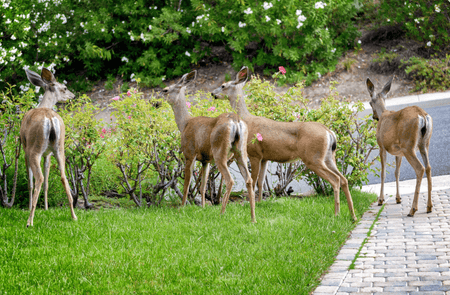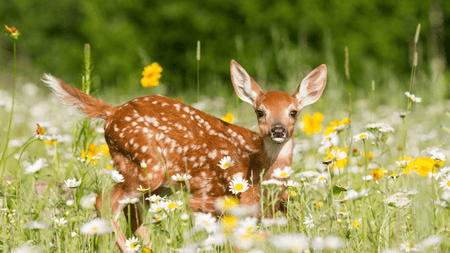Seasonal Native Plant Care Calendar: Year-Round Guide to Thriving Wildlife Gardens


Gardening can be a wonderful and rewarding hobby, but it's not always a walk in the park, especially when it comes to taking care of plants. Some plants can be quite picky, demanding lots of time, water, and attention. But there's good news! Native plants are here to make gardening a whole lot easier.
What Are Native Plants?
Native plants are those that naturally grow in a specific area or region. They have been living and thriving in their natural habitat for millennia, even before people started cultivating ornamental gardens. Because they've been around for so long, they've learned to get along with the local weather, soil, and wildlife. That's what makes them easy to care for. Even easier than turf grass!
Native plants are often celebrated for their lower maintenance requirements, making them an excellent choice for gardens and landscapes. These plants have evolved to thrive in specific regions over thousands of years, and their adaptations offer several advantages when it comes to reducing the time, effort, and resources needed for care and maintenance.
7 Reasons Native Plants Are Easier To Care For
1. Climate Adaptation: Native plants are well-suited to their local climate conditions where they evolved. They thrive in the natural weather patterns, temperatures and seasonal changes.
2. Pest and Disease Resistance: Native plants have established natural defenses against local pests and diseases. They have coevolved with native insects and pathogens, which often keeps pest problems at bay. This reduces the need for chemical pesticides and frequent inspections.
3. Soil Compatibility: Native plants are adapted to the specific soil types found in their native range. This reduces the need for soil amendments and fertilizers, as they can thrive in the existing soil conditions. This adaptability also helps prevent soil erosion.
4. Low Maintenance Watering: Once established, native plants typically require minimal irrigation. Their deep root systems allow them to access water from deeper in the soil, reducing the need for frequent watering. This not only saves water but also reduces the labor required for maintenance.
5. Reduced Pruning and Trimming: Native plants often grow to a size and shape that suits their environment. They generally don't require extensive pruning or trimming to maintain their natural form. This reduces the time and effort needed to keep the landscape looking tidy.
6. Wildlife Attraction & Support: Native plants provide habitat and food for local wildlife, including birds, butterflies, bees and other pollinators. By attracting these natural allies, they contribute to a balanced ecosystem, reducing the need for additional pest control measures. Many wildlife species cannot survive without native plants in the landscape.
7. Aesthetic Beauty: Native plants offer diverse and unique aesthetics, showcasing the natural beauty of the region. Their ability to thrive with minimal intervention often results in a sustainable landscape (and less work for you). Some will reseed themselves, and you can divide some perennial native plants to share with neighbors or other gardening enthusiasts in that native plant’s region. A garden that grows itself is a win-win.
How To Care For Native Plants in Each Season
Native plants are a beautiful and sustainable addition to any garden, but like any garden space, some routine maintenance is a good thing. In this guide, we'll take you through a seasonal calendar of essential tasks to keep your native plant garden healthy and vibrant throughout the year.
Spring: March - May
Clean Up and Prune:
- Don’t remove fallen leaves in your beds. Many beneficial insects, including some butterflies and many moth species, overwinter in the fallen leaves. Their caterpillars are a critical food source for baby birds in spring.
- Cut last year’s perennial stems back to around 12 inches. Native bees use cut stems as nesting spots.
- Prune any damaged or overgrown branches on trees and shrubs
- Mulch as needed to conserve moisture and suppress weeds.
Planting:
- Spring is a great time for planting. Add more native species, like specific spring blooms for early pollinators.
- Divide and transplant any overcrowded native plants.
Related reading:
Spring Garden Care Guide
Native Plants for Spring Blooms and Pollinators
Summer: June - August

It's time to enjoy the fruits of your labor in the summer! Take note of blank spots in your garden, and be sure to take lots of pictures. Tag #GardenForWildlife when you post!
Watering:
- If conditions are excessive hot and dry, some watering may be necessary.
- Occasional deep watering is better than frequent shallow watering.
- Water in the morning to reduce evaporation and wet leaves overnight, which can contribute to mildew and other plant issues.
- Consider using soaker hoses or drip irrigation to conserve water.
- Consider adding a water source for wildlife to use in the upcoming summer months. A bird bath is an easy start! Just be sure to clean regularly.
Pest and Weed Control:
- Keep an eye out for pests and signs of disease. Monitor to see if any action is needed (often it’s not).
- Hand pick weeds before they become established.
Deadheading:
- Trim spent flowers to encourage continuous blooming.
- Leave some seedheads for wildlife.
Related reading: Summer Garden Care Guide
Fall: September - November

Pictured: Grayleaf Goldenrod (Solidago nemoralis) can bloom into October to help migrating wildlife and provide color as weather starts to cool.
Pruning and Cleanup:
- Trim back any dead or diseased growth.
- Don’t get rid of all the fallen leaves. The natural leaf layer is critical habitat for many birds, insects and other wildlife. Here are some pro-tips on how to do it the right way.
Planting:
- Fall is an excellent time for planting, just before plants go dormant. This reduced risk of transplant shock and gives plants time to get their roots established underground before the spring growing season.
- Add late-blooming native plants to extend the season.
Related reading:
Fall Garden Care Guide
Is Fall A Good Time To Plant?
Flowers That Thrive In Fall
Winter: December - February
Protection:
- Avoid pruning during this season.
- Heavy snows can snap branches of trees and shrubs. Use a broom to knock snow off.
Bird Feeders and Habitats:
- While many shrubs can provide berries and cover in colder months, you can set up bird feeders and shelters to support wildlife in winter.
Planning:
- Research and plan for new native plant additions in the coming year.
- Consider adding a water feature for wildlife. Just be sure to clean regularly!
- Reflect on your garden's successes and challenges from the past year. Be sure to share your insights with your neighborhood or community to help others with their goals to garden for wildlife. It does take a village!
Related reading: Winter Garden Care Guide
By following this seasonal native plant care calendar, you can ensure your garden remains a haven for biodiversity and beauty year-round. Native plants not only require less maintenance but also provide valuable resources for local wildlife. Embrace the rhythm of the seasons and watch your native garden flourish!

Find Native Plants by Zip Code
We took the guesswork out of planting native. Check your zip to see what ships!



















